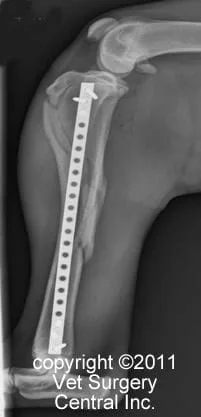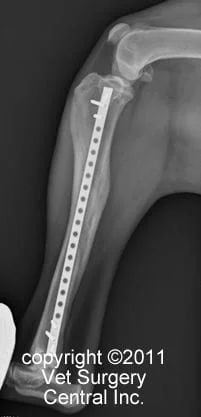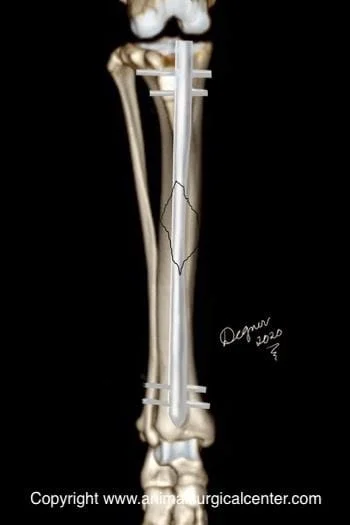Key Points
MIO = minimally invasive osteosynthesis
Tibial fractures are now being repaired with minimally invasive surgery using MIO
Benefits of this type of surgery includes
- small incisions
- less patient discomfort
- rapid healing of fractures
Initial visit- downloadable forms/information for clients:
History sheet - Client initial consultation history
Client education handout - tibial fractures
Discharge instructions for postop care - dog
Discharge instructions for postop care - cat
2-week recheck visit - downloadable forms/information for clients:
History form - 2 week postop (Telemedicine evaluation) - dog and cat
Postop care instructions 2-week fracture repair recheck - cat
Postop care instructions 2-week fracture repair recheck - dog
8-week recheck visit - downloadable forms/information for clients:
History form 8-week fracture recheck (in hospital) - dog and cat
Postop care instructions 8 week fracture recheck - dog
Postop care instructions 8 week fracture recheck - cat
Downloadable forms for referring veterinarians:
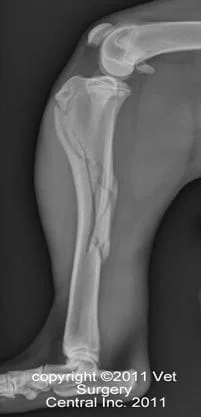
Anatomy
Fractures of the tibia bone can occur from an external force such as being stepped upon or a direct blow. Internal fracturing forces such as excessive twisting of the bone can occur when a pet pivots around when playing. In young puppies, the soft bones are more susceptible to spiral fractures, whereas adults have a tendency to develop complex, multiple fragment fractures. These complex fractures are usually caused by major trauma which is induced by a direct blow, frequently associated with a motor vehicle accident.
Surgery
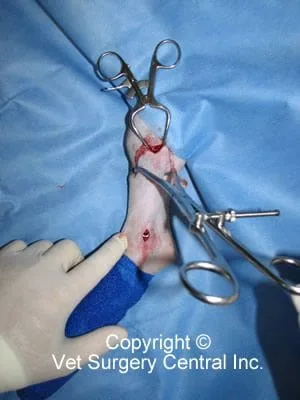
Your pet’s surgeon will let you know if the presenting fracture is best treated with a minimally invasive procedure. Two small incisions are used to perform the procedure called minimally invasive osteosynthesis (MIO). A button-hole incision is made at the top and bottom ends of the fractured bone (compare this to traditional surgery to repair the tibia bone. With the aid of digital x-rays or fluoroscopy, a stainless steel surgical plate, that is almost the length of the bone, is slid under the skin and over the bone. Two or three screws are used to secure the bone plate on each end of the bone. Because MIO mandates that no surgical incision is made directly into the fracture site, minimal disruption of the initial blood clot that is surrounds the fracture occurs. Thus, the important healing substances (growth factors) at the fracture site are preserved. MIO results in a somewhat flexible bone/implant construct. This flexibility stimulates the bone to heal very rapidly with callus. In fact, in an immature animal, the healing process is so advanced by 14 days after surgery that the metal plate and screws frequently can be removed at this time. Implant removal only requires two button hole incisions to remove the implants, thus the procedure is usually done on an outpatient basis.
Another Implant option for MIO is the interlocking nail in which a metal rod is placed down the marrow cavity. Two bolts are used to lock the bone to the rod on each end of the bone.
Homecare
Prescribed oral pain reliever should be administered for 2 to 4 days. Nonsteroidal anti-inflammatory medications may be a part of the pain management protocol, but long-term administration of this medication will impede bone healing. A soft padded bandage with a splint will be placed on the limb for most patients that have a MIO procedure, yet other cases may only have a bandage is applied. The bandage/splint is typically removed about 1 week after surgery, but your companion’s surgeon will let you know how long the splint is needed. It is extremely important to limit your companion’s activity and exercise level during the post-operative period. Detailed instructions will be given to you after the surgery. The surgeon will monitor the healing process with at least two follow-up exams. The first is scheduled at two weeks after the surgery and x-rays are usually made during this visit to see if the fractures have healed. During the second exam, at three to five weeks after the surgery (depending on the age of the pet), radiographs will be made again to evaluate the healing process.
Results
Surgical repair of a fractured tibia with MIO offers multiple benefits including a faster bone healing, faster recovery, earlier use of the limb after surgery, and excellent range of motion of the joints above and below the fracture. Uncommon complications include infection, shifting of the fractures, breakage of the metal plate or screws, and malalignment of the limb after healing has taken place (x-ray below left is immediately after surgery and x-ray below right is after the bone has healed).
